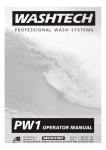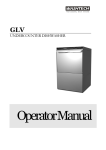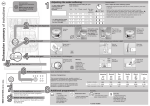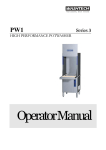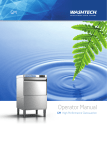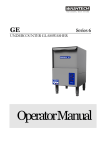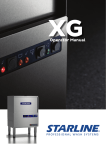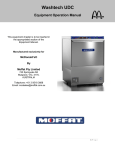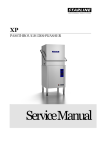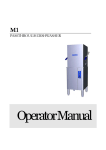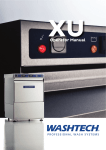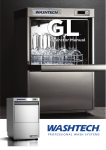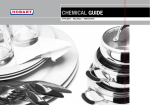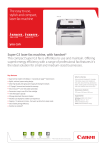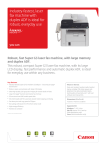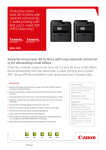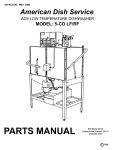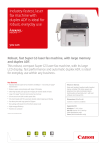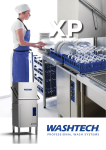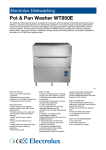Download Moffat Service Manual
Transcript
GLV 81 OPERATOR MANUAL Service 1 800 622 216 Distributed in Australia by Parts 1 800 337 963 740 SpringvaleRoad, Mulgrave 3170, Victoria, Tel 03 9518 3888 Fax 03 9518 3818 82 Safe Installation and Use of Wash Equipment As with all electrical and mechanical equipment dishwashing equipment can be hazardous if installed or operated incorrectly. 9 9 9 9 9 9 9 9 9 Installation Use qualified, skilled personnel Follow installation instructions Connect to correct voltage and supply current Provide fully accessible Electrical Isolation Switch Training and Supervision Read and Understand the Operating instructions Train all staff. This appliance is not intended for use by young children. Young Children should be supervised to ensure they do not play with the appliance. This appliance is not intended for use by infirm persons without supervision Hot Surfaces 9 Be aware some surfaces can be hot. 9 9 9 9 Chemicals Commercial dishwashing detergents are hazardous Read and follow the safety information found on the labels of detergent containers and Material Safety Data Sheets Handle with care Use protective eyewear and clothing if decanting containers Hot Water 9 Door safety switches are designed for emergency use only. 9 WAIT for the green cycle light to go out before opening the door. 9 Wash water is 60°C and contains caustic detergent so DO NOT put hands in wash water. Cleaning 9 DO NOT hose down the machine or splash water over the exterior. 9 Watch for broken glass etc when cleaning the inside of the machine especially with glasswashers.. If the supply cord is damaged it must be replaced by the manufacturer or its service agent or a similarly qualified person in order to avoid a hazard. For further information on any of the above contact 83 Service 1 800 622 216 Distributed in Australia by Parts 1 800 337 963 740 SpringvaleRoad, Mulgrave 3170, Victoria, Tel 03 9518 3888 Fax 03 9518 3818 GLV OPERATING INSTRUCTIONS START UP Fit wash pump filter, scrap trays and shut door. Turn wall and machine power switches ON. ON light glows red and machine fills automatically. When the RINSE READY light (tick symbol) and WASH READY light (water symbol) glow amber the machine is ready to run and may be started. OPERATION Load rack into machine and shut door. Press start button (1,2 or 3) for 1,2 or 3 minutes accordingly. CYCLE light glows green while machine operates. When CYCLE light goes out, cycle is complete. Remove rack. Close door. Note: Machine will not operate unless READY lights are ON. SHUT DOWN - IMPORTANT - EVERY NIGHT Open the door and turn DRAIN switch on. Allow to drain for approximately 2 minutes Turn DRAIN and POWER switches off. Remove scrap trays and wash pump filter, rinse clean and replace. We recommend regular removal and flushing of wash and rinse arms. To remove arm assembly, undo thumbscrew. To clean wash/rinse arms use a toothpick or paperclip, if necessary, to clear the jets, remove end screws from arms and flush with water/. Use of correct type and quantities of detergent is essential to the effective operation of this machine. Use only low foam detergents. Contact your chemical supply company to either fit an automatic dispenser or to supply suitable powder detergent to manually add to wash water. For information on recommended detergent suppliers or local service agents, contact: Rev 1A 20/5/04 84 Service 1 800 622 216 Distributed in Australia by Parts 1 800 337 963 740 SpringvaleRoad, Mulgrave 3170, Victoria, Tel 03 9518 3888 Fax 03 9518 3818 GETTING THE BEST RESULTS FROM YOUR DISHWASHER 1. Hot Water Supply An adequate supply of water at the correct temperature and pressure is essential for effective operation of your machine. An inadequate hot water supply will result in significant time delays between operating cycles. Refer Installation information for detail. Water softening is recommended in hard water areas - especially for glasswashing. 2. Pre-rinsing Pre-scraping of dishes is required by Food Hygiene Regulations. The best method is to prerinse with warm water with a Fisher Pre-rinse Unit - or alternatively by scraping or dunking in water. Cutlery should be pre-soaked in warm water, preferably containing cutlery pre-soak compound - refer your chemical supplier. 3. Racking Procedures Do not overload racks or cutlery containers, minimise the overlap of crockery. Cycle times are short and water consumption per cycle low - so there is no advantage in overloading racks. 4. Cycle Times With multi-cycle machines select cycle 3 initially and switch to faster cycles only if necessary. Note that water consumption does not increase with longer cycles. For best results use the longest cycle whenever possible. 5. Detergent Use of correct type and quantity of detergent is essential to the performance of the machine. Low foam specialty products are recommended. We strongly recommend that you use a professional dishmachine chemical supplier - and will be pleased to recommend a supplier in your region. Discuss with them the use of cutlery pre soak solution, detergent and drying agent. 6. Drying Single tank commercial dishwashers do not have a drying cycle. However, the machines do rinse at high temperatures which promote fast drying particularly when drying agents are used. We recommend prompt removal of the rack from the machine - leave the rack on the bench for 2 to 3 minutes before emptying. This time will be reduced with correct use of drying agent (rinse fluid) which reduces water surface tension and allows water to drain quickly from washware. For advice on drying agents and injectors refer to your chemical supplier. 7. Daily Cleaning It is essential that the machine is drained and cleaned at the end of each day. Drain the machine then remove, clean and replace filters as per the operating instructions. Regularly check the wash and rinse jets. Remove wash and rinse arms by undoing the central thumbscrew. (DO NOT remove the thumbscrew retainer plate if fitted). Flush arms with water and use a toothpick or paperclip, if necessary, to clear jets. On some models individual jets can be removed for cleaning by twisting anticlockwise. To remove the end plugs on these arms first remove the end jet then withdraw end plug. To flush the machine, leave the drain upstand out, close the door and switch the machine on for about 20 seconds. DO NOT leave the machine unattended during this process. 85 86 87 88 Ian Mcleod 89 Ian Mcleod 10 9 8 7 6 5 4 3 2 1 J J REAR VIEW I I PERSPECTIVE VIEW H H DETAIL A 10 G G 4 1 8 F F 5 9 DETAIL A 2 12 3 3 E E 6 8 6 1 D D 4 11 10 9 3 3 5 2 C C Parts List ITEM B A PART NUMBER DESCRIPTION QTY 1 600 30163 LENS & NEON ASSY (GREEN) 12mm 1 2 600 30161 LENS & NEON ASSY (RED) 12mm 1 3 600 30162 LENS & NEON ASSY (AMBER) 12mm 2 4 600 30212 3 BANK 1 POLE MOMENTARY SWITCH 1 5 32271 TERMINAL STRIP 4 WAY 1 6 600 80003 M4 NUTSERT 2 7 8802 MS PAN POZI ZP M4x25 2 8 600 30213 SWITCH DRAIN 2P NO/NC 1 9 600 30214 SWITCH POWER 2P NO/NO 1 10 251 10042 GLV4 STARLINE/WASHTECH CONTROL PANEL ASSY 1 11 400 70041 WASHTECH GLV CONTROL PANEL LABEL 1 POWER TERMINAL LABEL 9 1 12 REF 10 90 8 7 7 Alexander Jouk 414 ROSEBANK ROAD AUCKLAND Tel (09) 829-0930 C Proj: Description: Units: mm GLV4 WASHTECH CONTROL PANEL ASSY Tolerance: Finish: Material: REF 7 6 5 Scale: +/-0.5 N.T.S. Drawn by: Approved by: 3 1-A Issue Date: Sheet No. Drawing No: 23/09/2004 1 /1 PROJECT: 4 Rev. Checked by: BAE DO NOT SCALE - IF IN DOUBT ASK B PO Box 90-548 New Zealand Fax (09) 829-0935 251 10004 A SPECIFICATION SUBJECT TO CHANGE WITHOUT NOTICE 2 1 Alexander Jouk 91 92












